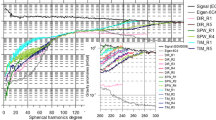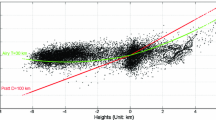Abstract
We discuss some theoretical aspects and practical consequences of using traditional versus “new”/rigorous formulations of the Bouguer and isostatic gravity anomalies/disturbances. In principle, the differences between these two concepts are in the definition of the so-called secondary indirect topographic effect (SITE) on the gravity data. Although we follow the tradition to call this effect SITE, we show that it is formally a direct topographic effect (DITE), needed to remove all topographic signal, but in practice not regarded as such. Consequently, there is a need for a no-topography gravity anomaly, which removes all topographic effects, leaving the below-crust Earth transparent for gravity inversion. Similarly, a rigorous isostatic gravity anomaly includes also a compensation effect for the SITE. By using a simple topographic model, we confirm a theoretically found ratio of 2/(n + 1) between the magnitudes of the SITE and DITE by wavelength (spherical harmonic degree n), both for the Bouguer and isostatic gravity anomalies. Finally, global gravity inversions are applied by utilizing the Vening Meinesz-Moritz isostatic model to determine the Moho geometry using the Bouguer gravity disturbances/anomalies and the no-topography gravity anomalies, and the results are compared. The numerical results confirm our theoretical findings that the Bouguer gravity disturbances and the no-topography gravity anomalies provide very similar results. A comparison of these gravimetrically computed Moho depths with the CRUST1.0 seismic model shows rms agreements of 4.3 and 4.5 km, respectively. This is a significant improvement when compared to the Moho result obtained by using the Bouguer gravity anomalies, yielding the rms difference of 7.3 km for the CRUST1.0 model. These results confirm a theoretical deficiency of the classical definition of the Bouguer and isostatic gravity anomalies, which do not take into consideration the SITE effects on the topography and its compensation.









Similar content being viewed by others
References
Bagherbandi M, Sjöberg LE (2013) Improving gravimetric-isostatic models of crustal depth by correcting for non-isostatic effects and using CRUST2.0, Earth-Science Rev 117: 29–39.
Hackney RI, Featherstone WE (2003) Geodetic versus geophysical perspectives of the “gravity anomaly”. Geophys J Int 154: 35–43.
Heiskanen WA, Moritz H (1967) Physical Geodesy, W.H. Freeman and Co., San Francisco and London.
Hinze WJ et al (2005) New standards for reducing gravity data: The North American gravity database. Geophys 70(4): J25–J32.
Laske G, Masters G, Ma Z, Pasyanos M (2013) Updates on CRUST1.0- A 1-degree Global Model of Earth’s Crust, Geophys Res Abstr, 13, EGU2013-2658.
Li X, Götze H-J (2001) Ellipsoid, geoid, gravity, geodesy, and geophysics. Geophys 66: 1660–1668.
Moritz H (1990) The figure of the Earth, Wichmann, Karlsruhe.
Sjöberg LE (1994) The total terrain effect in the modified Stokes´ formula. In H. Sünkel and I. Marson (Eds): Gravity and Geoid, IAG Symposia 113, Springer Verlag, pp. 616–623.
Sjöberg LE (1996) On the error of analytical continuation in physical geodesy. J Geod, 70: 724–730.
Sjöberg LE (1997) The total terrain effect in gravimetric geoid determinations. Boll Geod Scie Aff, LVI: 209–222.
Sjöberg LE (2000) Topographic effects by the Stokes-Helmert method of geoid and quasi-geoid determinations. J Geod, 74(2): 255–268.
Sjöberg LE (2007) The topographic bias by analytical continuation in physical geodesy. J Geod, 81: 345–350.
Sjöberg LE (2009) Solving Vening Meinesz-Moritz inverse problem in isostasy. Geophys J Int 179: 1527–1536.
Sjöberg LE (2013) On the isostatic gravity anomaly and disturbance and their applications to Vening Meinesz-Moritz inverse problem of isostasy Geophys J Int (2013) 193: 1277–1282.
Tenzer R, Bagherbandi M (2012) Reformulation of the Vening Meinesz-Moritz inverse problem of isostasy for isostatic gravity disturbances. Int J Geosci 3: 918–929.
Tenzer R., Chen W., Tsoulis D., Bagherbandi M., Sjöberg L.E., Novak P., Jin S. (2015) Analysis of the Refined CRUST1.0 Crustal Model and its Gravity Field. Surv Geophys (2015) 36: 139–165, doi:10.1007/s10712-014-9299-6.
Vajda P, Vaníček P, Meurers B (2006) A new physical foundation for anomalous gravity. Stud Geophys et Geod 50(2): 182–216.
Vajda P, Vaníček P, Novak P, Tenzer R, Ellmann A (2007) Secondary indirect effects in gravity anomaly data inversion or interpretation, J Geophys Res 112 (B06411): 1–11.
Vaníček P, Tenzer R, Sjöberg L E, Martinec Z, Featherstone E W (2004) New views of the spherical Bouguer gravity anomaly. J Geophys Int 159(2): 460–472.
Author information
Authors and Affiliations
Corresponding author
Appendix
Appendix
The detailed formulas for computing the topographic potentials and attractions of the spherical cylinder (cf. Sjöberg 2007) and its isostatic compensation by Airy–Heiskanen’s compensation model.
The topographic potential V T P at any point P of radius r P along its axis is given by
where \( \mu = G\rho \), \( l_{P0} = \sqrt {r_{P}^{2} + r^{2} - 2r_{P} r\cos \psi_{0} } \). Eq. (14) can be integrated to
where
Generally, the topographic gravity anomaly and gravity disturbance effects become
For the spherical cylinder one obtains
where
with
and
The compensation potential for Airy–Heiskanen’s isostatic model applied to the spherical cylinder is given by the integral
where t = 4.45H, where H is the topographic height (cf. Heiskanen and Moritz 1967, pp. 135–136), and Δρ is the density contrast between the crust and mantle. The integral can be evaluated to
and the compensation attraction becomes
Rights and permissions
About this article
Cite this article
Sjöberg, L.E., Bagherbandi, M. & Tenzer, R. On Gravity Inversion by No-Topography and Rigorous Isostatic Gravity Anomalies. Pure Appl. Geophys. 172, 2669–2680 (2015). https://doi.org/10.1007/s00024-015-1032-y
Received:
Revised:
Accepted:
Published:
Issue Date:
DOI: https://doi.org/10.1007/s00024-015-1032-y




